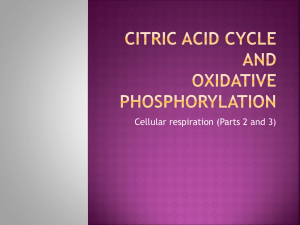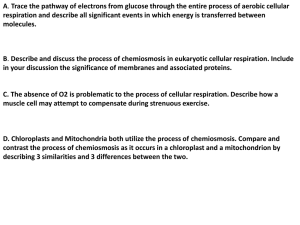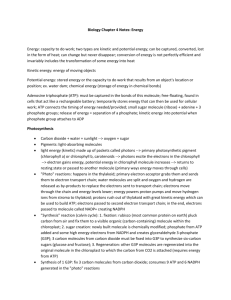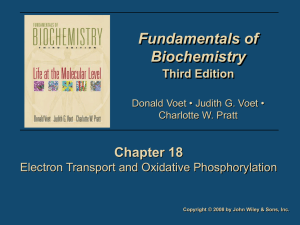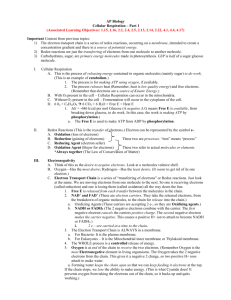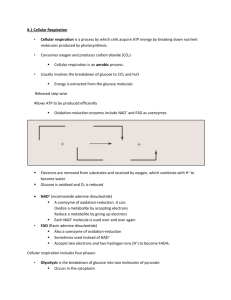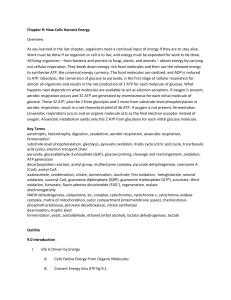Bio93 Discussion TA: Carley Karsten e
advertisement
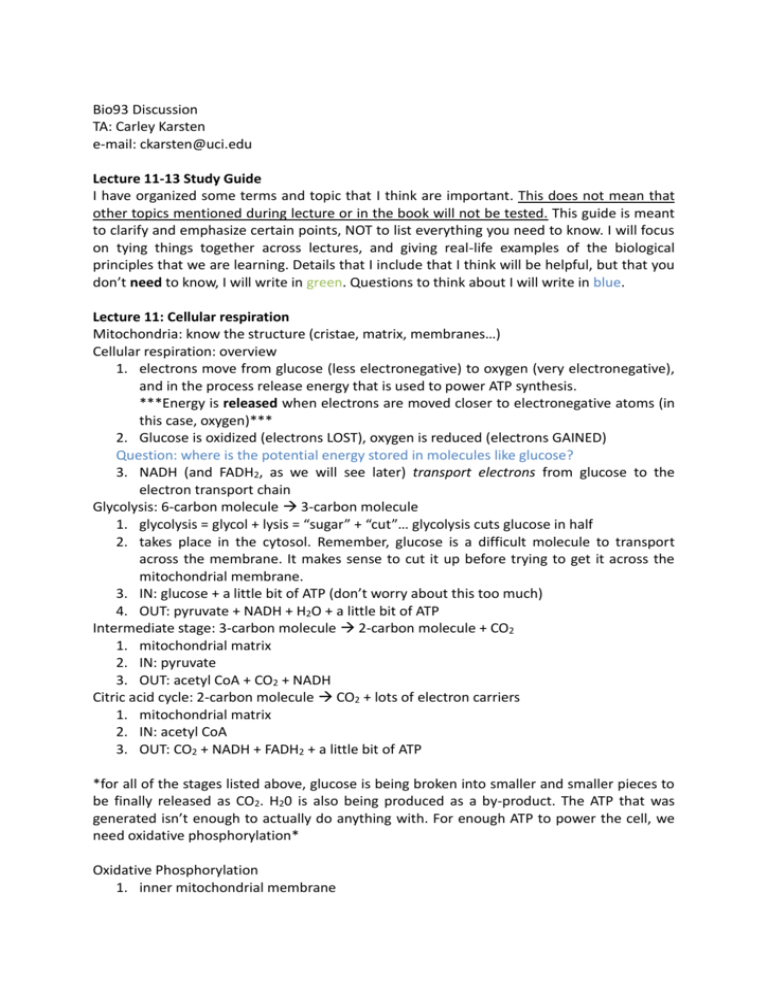
Bio93 Discussion TA: Carley Karsten e-mail: ckarsten@uci.edu Lecture 11-13 Study Guide I have organized some terms and topic that I think are important. This does not mean that other topics mentioned during lecture or in the book will not be tested. This guide is meant to clarify and emphasize certain points, NOT to list everything you need to know. I will focus on tying things together across lectures, and giving real-life examples of the biological principles that we are learning. Details that I include that I think will be helpful, but that you don’t need to know, I will write in green. Questions to think about I will write in blue. Lecture 11: Cellular respiration Mitochondria: know the structure (cristae, matrix, membranes…) Cellular respiration: overview 1. electrons move from glucose (less electronegative) to oxygen (very electronegative), and in the process release energy that is used to power ATP synthesis. ***Energy is released when electrons are moved closer to electronegative atoms (in this case, oxygen)*** 2. Glucose is oxidized (electrons LOST), oxygen is reduced (electrons GAINED) Question: where is the potential energy stored in molecules like glucose? 3. NADH (and FADH2, as we will see later) transport electrons from glucose to the electron transport chain Glycolysis: 6-carbon molecule 3-carbon molecule 1. glycolysis = glycol + lysis = “sugar” + “cut”… glycolysis cuts glucose in half 2. takes place in the cytosol. Remember, glucose is a difficult molecule to transport across the membrane. It makes sense to cut it up before trying to get it across the mitochondrial membrane. 3. IN: glucose + a little bit of ATP (don’t worry about this too much) 4. OUT: pyruvate + NADH + H2O + a little bit of ATP Intermediate stage: 3-carbon molecule 2-carbon molecule + CO2 1. mitochondrial matrix 2. IN: pyruvate 3. OUT: acetyl CoA + CO2 + NADH Citric acid cycle: 2-carbon molecule CO2 + lots of electron carriers 1. mitochondrial matrix 2. IN: acetyl CoA 3. OUT: CO2 + NADH + FADH2 + a little bit of ATP *for all of the stages listed above, glucose is being broken into smaller and smaller pieces to be finally released as CO2. H20 is also being produced as a by-product. The ATP that was generated isn’t enough to actually do anything with. For enough ATP to power the cell, we need oxidative phosphorylation* Oxidative Phosphorylation 1. inner mitochondrial membrane 2. IN: NADH and FADH2 3. OUT: lots of ATP! and water (by-product) 4. Electron transport chain (ETC) a. NADH and FADH2 donate electrons to first protein in the ETC (“I”) b. electrons move down the chain IIIIIIIV, each protein more electronegative than the last c. potential energy released from electrons down the chain is used to pump H+ against its gradient from the mitochondrial membrane to the intermembrane space d. electrons finally move from IVoxygen, the most electronegative part of the ETC, to make water (by-product) e. the H+ gradient across the inner mitochondrial membrane stores a lot of potential energy. As H+ moves down its concentration gradient, ATP synthase harnesses the energy to generate ATP. Lecture 12: Photosynthesis Chloroplasts: know the structure (thylakoid, membranes, etc…) Photosynthesis: overview 1. CO2 is reduced (electrons GAINED), water is oxidized (electrons LOST) 2. movement of electrons from water (low potential energy) to sugar (high potential energy) requires energy… solar energy. 3. chlorophyll captures light to power photosynthesis. When it absorbs a photon, one of its electrons is pushed away from the atom’s nucleus. This results in it being in a higher energy state than it was before. Light reactions: use solar energy to make substrates for the dark reactions 1. thylakoids 2. IN: light and water 3. OUT: NADPH (similar to NADH used in cellular respiration) + ATP + oxygen 4. photosystems: although they’re named “I” and “II”, “II” comes before “I” a. PS II: light H+ gradient across thylakoid membrane (to power ATP synthase) b. PS I: light NADPH synthesis c. together: produce ATP and NADPH for use in the Calvin Cycle (dark reactions) Dark reactions: “carbon fixation” 1. stroma 2. IN: CO2 (gas from the air) + ATP and NADPH (from light reactions) + RuBP (recycled from previous Calvin Cycle) 3. OUT: G3P (a small sugar that can go on to make glucose and other macromolecules) + RuBP (to be used in the next Calvin Cycle) Tricky clicker question: the radish plant experiment. Why is the answer 2>1>3 (B)? Let’s break it down. 1. seeds: contain starch and other fuel needed for growth. However, without light and water it can’t use those fuels. Therefore, it is neither using nor producing any sugars. 2. healthy plant: since it has access to light and water, it will produce its own glucose / starch / etc., adding to its mass every time it completes a Calvin Cycle. 3. sick plant: given water, the seeds were allowed to germinate and begin to grow, using up their stores of energy. However, without light it cannot begin to produce its own sugars. Therefore it cannot gain mass. Think about how cellular respiration and photosynthesis are similar, as well as how they’re different. How does potential energy change? What happens to glucose? How are mitochondria and chloroplasts similar in structure? Lecture 13: Cell cycle / mitosis Take a second and think about how amazing it is that you started as one cell. While cell division can be dangerous, as in cancer, it is also necessary for life as we know it. Chromosome = single molecule of DNA. Several levels of structure: 1. nucleotides 2. DNA double helix 3. DNA wraps around nucleosomes (bundles of histones) 4. chromatin (DNA + histones) coils 5. coils of chromatin coils 6. chromosome Interphase 1. G1: cellular components duplicate (macromolecules and organelles). Remember, we’ll need two of everything when this cell finally divides into two. 2. S: DNA replicates 3. G2: checkpoint for cell cycle regulators (more on these in lecture 15) 4. When interphase ends, the cell is pretty much normal… it just has two of everything. Mitosis nuclear envelope chromosomes mitotic spindle prophase intact Very condensed. Sister chromatids joined at centromeres, and along the arms (using cohesins). Begins to form. Centrosomes begin to move away from each other. prometaphase fragments Even more condensed. Sister chromatids now have kinetochores at their centromeres. invade the nuclear area to attach to kinetochores metaphase none lined up at the metaphase plate (middle of the cell) centrosomes are at opposite sides of the cell anaphase none cohesins are broken, allowing sister chromatids to separate kinetochore microtubules shorten, moving centromeres away from the center. nonkinetochore microtubules lengthen, elongating the cell. telophase / cytokinesis beginning to re-form chromosomes decondense depolymerization (breaking down) of microtubules


